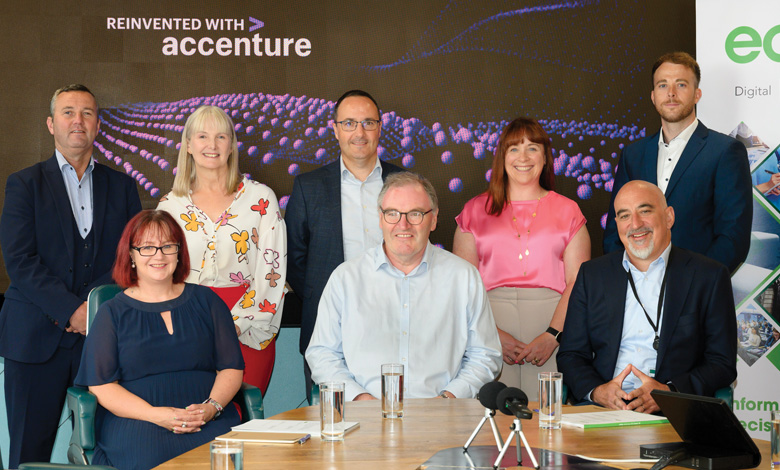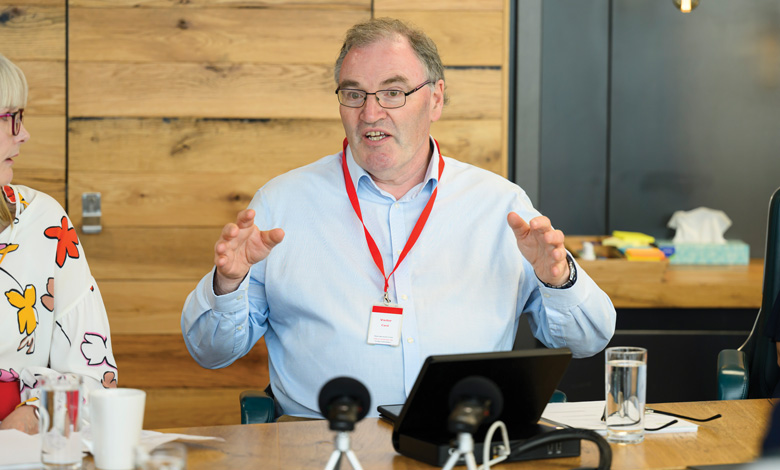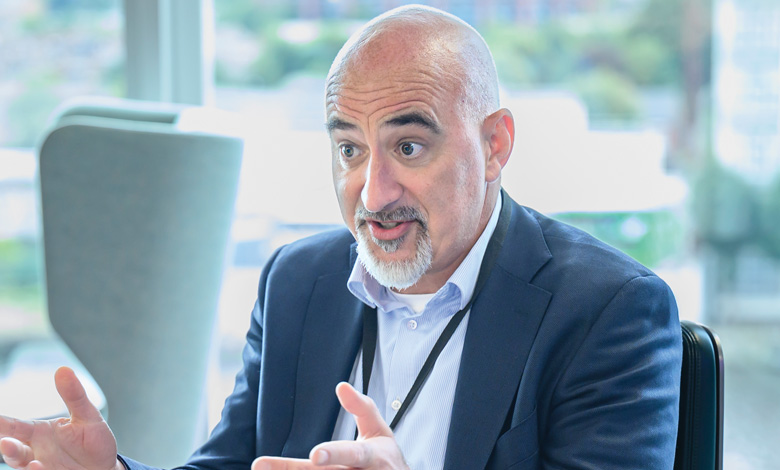Backlog to breakthrough: How automation and AI are transforming public services

Accenture hosted participants from across the public sector to engage in a round table discussion designed to determine how automation and AI are transforming the delivery of public services.
What are the most significant use cases of AI driving public service transformation?

Francis McGuire
The UK’s Department of Work and Pensions implemented a GenAI solution to process handwritten letters, significantly improving response times and ensuring quicker access to social welfare support. This demonstrates how GenAI can streamline laborious tasks and enhance public service efficiency.
Sam Waide
From an RSA perspective, the best use case has been the rollout of the RSA customer contact centre. We can leverage AI to quickly determine pertinent information about the customer, including their driving history and penalty points. For both staff in the centre and customers, this access to real-time information has accelerated interactions.
Nicola Roche
The Department of Agriculture, Food and the Marine has partnered with external partners and developed an AI solution to determine bovine TB risk at animal level which enables us to detect potential cases and reduce instances of bovine TB in Ireland. Simultaneously, the Department is collaborating with Met Éireann to better understand the impact of climate change and look at prospective agricultural land challenges.
Neil O’Hare
Ambient speech technology provides the ability to record and process verbal interactions between patients and clinicians. It negates the need for clinicians to manually write notes with the speech recognition and interpretation technology that can automatically draft the notes. Another exciting development is the National Children’s Hospital, which will be an intelligent building with a lot of data and sensors. We can leverage AI to ensure we are running that hospital efficiently from an energy perspective, and from an access perspective.
Jane Corr
Most people in the country utilise CIÉ’s services, so the main thing for us is ensuring that we leverage the associated data. In Singapore’s public transport system, for example, AI is used to deliver virtual messages in sign language to users. There is a chance to deliver for every citizen and improve all our public infrastructure if we can ensure that AI is properly integrated into public services.
What is the potential for responsible AI use to enhance public service delivery?
Neil O’Hare
We need to prioritise making our services accessible to end-users and that requires more cohesive policy guidance. We must better communicate the potential use cases and guard rails with our end-users.
Sam Waide
The predominant way to ensure responsible AI use is to ensure that our goals are understood. For road safety, the objective is to have zero deaths and zero injuries by 2050. There is tremendous opportunity for AI toolchains to benefit road safety. The RSA understands its role in the bigger picture of the digitalisation public services, and AI can contribute to the pursuit of Vision Zero, however safety needs precision
“To overcome this challenge of trust, we need end-users to understand the capabilities and limitations of the technology.”
Neil O’Hare
Jane Corr
There is a culture change required within the public sector. Comparing the private sector to the public sector, there is a much more risk-averse approach in the public sector which slows progress. Responsible AI use represents an opportunity in the public sector to improve user experience and enhance services.
Francis McGuire
Building public trust is key, and there is more emphasis on quality of delivery in the public sector because public services are citizen-solution based while companies are profit-driven. While there is less scope for pilot trials in the public sector, there is greater opportunity for building public support among the public. We need the public service to lead the charge and drive progress.
Nicola Roche
Being cautious and slower are natural things in the public sector. In the private sector, where competition and choice often result in an innovation race, whereas in the public sector, there is only one service provider – and no choice – meaning our service delivery must reach the highest of standards. People trust us with their data, and they must be confident that their data is secure. If the civil service or a public service body makes a mistake, the stakes are arguably higher than for private companies, given the potential impact on people’s lives. There are opportunities where we can be more agile, but we must not rush our approach to AI.
How can this potential for public service transformation be balanced against the associated challenges?
Jane Corr
When designing an AI framework, it needs to be deliberate. The governance needs to be established quickly to ensure accountability and enable the completion of risk assessments. The right set of security controls must also be established.
Francis McGuire
There are still perception challenges around AI. We are beginning to move beyond the idea that AI will lead to job loss and instead focusing on the rollout of responsible AI in a steady manner. This needs to be transparent and with clear governance demonstrating the role of human oversight. However, we must not overlook the efficiencies that AI can bring to public services.
Neil O’Hare
The challenge we have is that if there is an overreliance on AI, that the worker can become fundamentally deskilled. We must avoid exacerbating a data literacy deficit; this means teaching data literacy alongside an ability to use AI to allow us to ensure that what the AI gives us is valid. This is a challenge which applies across all age groups. Many submissions I receive in my academic capacity are easily recognisable as generative AI-produced work in my field, and the result is a knowledge shortfall in specialised settings. There are benefits to this technology and its use, but we need to proceed with caution.
“Stories of AI success will help bring the public on the journey with us.” Francis McGuire
Sam Waide
AI relies on data entry, and so AI-enabled solutions can only provide feedback on the source data. If the source data is either inaccurate or untrue, the challenge is that AI will provide inaccurate ‘solutions’. Digital literacy is another important aspect; there are already cohorts who are unable to use existing applications such as Microsoft Excel, so the potential for widening data illiteracy is significant.
Nicola Roche
We need to acknowledge that many of the regulations around AI are generated by people who look like us around this table, and there is a significant need to ensure that AI does not profile users by stereotypes to do with race, gender, or religion.
To what extent do the recently published Guidelines for the Responsible use of Artificial Intelligence in the Public Service support public service bodies to pursue responsible innovation?
Nicola Roche
The guidelines are asking us to have AI governance procedures in place to ensure that policy and implementation serves all people fairly and to the highest of standards. This means ensuring high-quality risk identification and bias testing. This requires care because if we only look within our own frame of reference, there could be bias or inaccurate analysis and solutions provided which do not reflect the needs of the user. Overall, these are good guidelines for all of us to follow not just with AI, but with policy more broadly.
Jane Corr
The best thing about the guidelines is that they are supportive, rather than a series of top-down orders. As public servants, we are tasked with doing the best for every citizen in this country, so there is scope for AI innovation but in a way in which people are served well.
“There are opportunities where we can be more agile, but we must not rush our approach to AI.”
Nicola Roche
Francis McGuire
The themes of accountability and need are the best aspects of the guidelines, because if progress is to be made there is a need for accountability which will steer us away from any potential risks. The aim must be to progress quickly, but we are ultimately serving citizens and that must be the underpinning policy of this transformative process. The new policy guideline document is brilliant and there is a lot of thought which went into it; the task now is policy implementation especially in the private sector.
Sam Waide
It is about moving at pace in a safe and steady manner. AI has existed since the 1950s, but it is only now that it is truly entering public consciousness. The guidelines are good, but implementation at pace is a challenge. The challenge is about figuring out how the transformative potential of AI can be underpinned by protection at a government level in a consistent manner across the public service. It requires a matrix approach at a government level, which is not always popular. However, a consistent approach is required if the public service is to share in best practice and foster innovation, whilst acknowledging that automation without oversight equals risk.
Neil O’Hare
There is a risk of creating a governance industry. Any AI tool we use is not home built; in most cases it is commercially procured from reputable vendors. Like any product we buy, we can perform a level of testing, but we do not validate it comprehensively; we assume that has already been completed as part of CE marking. Overlaying this with governance protection and safety regulation runs the risk of inadvertently creating an entire governance industry. If we want AI innovation and deployment, this level of regulation is unsustainable. What we need is transparency in vendors’ testing processes and for organisations to be able to have confidence in the product.
How can public services’ use of AI improve citizen trust and engagement?
Neil O’Hare
We are outlining the capabilities of the technology to end-users and determining if they are interested in deploying AI. Trust is crucial. I am reminded of the AI legal judge analogy; most people would choose a human over an AI solution to be the judge of a legal case they were involved in. However, AI will give you consistency and will not be subject to human weaknesses. To overcome this challenge of trust, we need end-users to understand the capabilities and limitations of the technology.
Francis McGuire
This is an exciting time. We have an amazing policy paper in the National AI Strategy. We are sitting in Accenture’s global headquarters for innovation and R&D activities, and all the surrounding companies are building AI models. In Ireland, we have access to knowledge and experience, a young workforce, and a government that aspires to digitalise all public services by 2030. Communication with the public is key to capitalise on context, and stories of AI success will help bring the public on the journey with us.
“If the public sector wants citizens to embrace AI, it must effectively communicate how the technology can make their lives easier…”
Jane Corr
Jane Corr
Irish people are adaptive. If we understand a new idea, we can run with it. Additionally, young people do not want to access public services in the traditional way. They are not interested. Even if the solution is only 75 per cent complete, they will take it every time over the alternative. If the public sector wants citizens to embrace AI, it must effectively communicate how the technology can make their lives easier in a transparent way.
Sam Waide
Different cohorts within society have different levels of interest in AI. Young people are excited about the technology, and they are interested in the companies that deploy it. It increases their interest in working for these organisations. There is a much wider engagement required beyond the AI transactional output or solution. In 2024, an inaugural road safety youth forum was established, and it occurred to me that a similar forum could be established for public service innovation. There are different ways to engage with people regarding AI, and it is important to involve young people because they are the leaders of tomorrow.
“A consistent approach is required if the public service is to share in best practice and foster innovation.”
Sam Waide
Nicola Roche
Do citizens care about AI? Arguably, the answer is no. But people do want better and faster public services delivered in a manner which makes sense for them. They want a single gateway where the can access their data. We need to prove that this service is transparent and offers value for money. The digital wallet and life events programme being prepared by the Office of the Government Chief Information Officer is an example of this.











